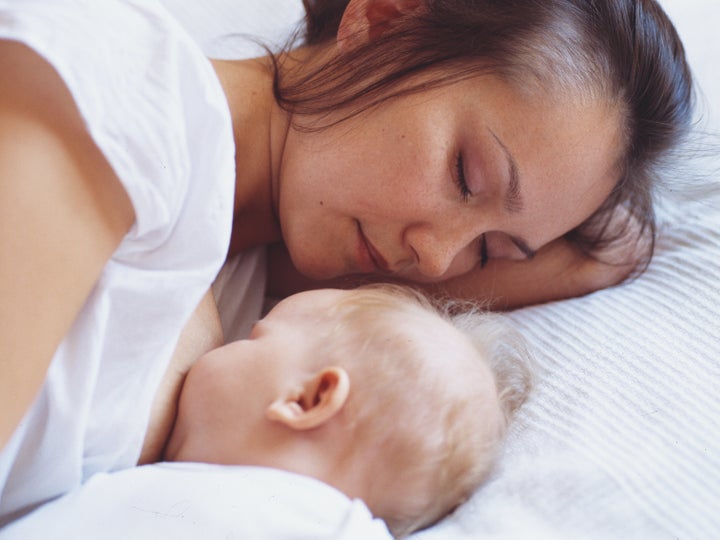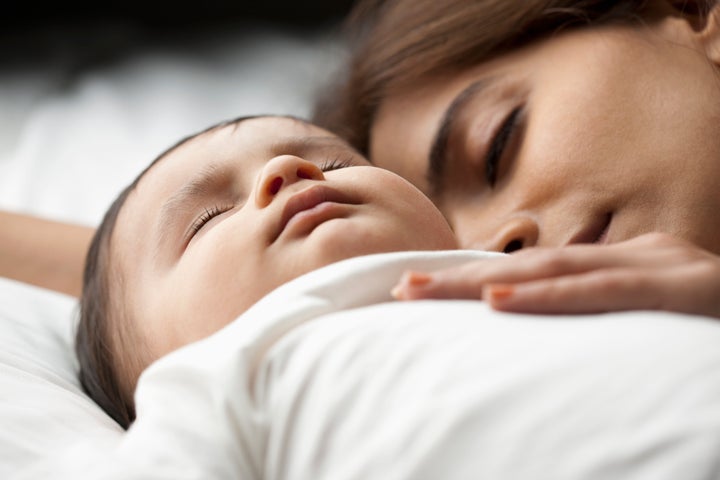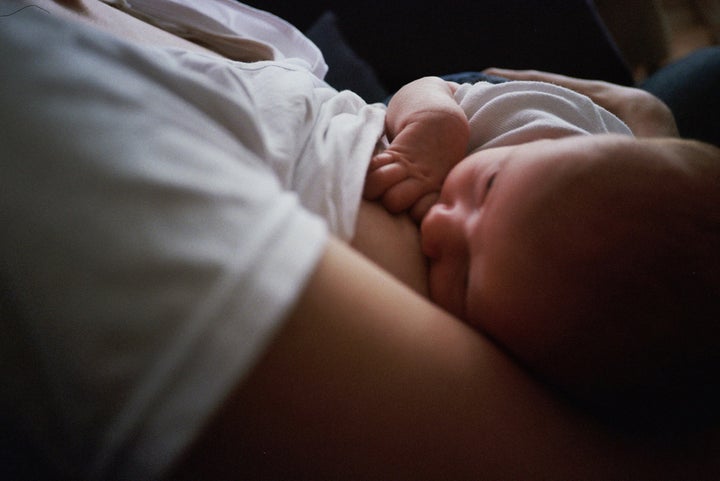
What is ‘breastsleeping’?
Breastsleeping is just what it sounds like: breastfeeding your baby while you both sleep in the same bed.
But haven’t mums been ‘breastsleeping’ since the beginning of time?
Well, yes. According to recent figures from the NCT, although most parents don’t plan to sleep with their baby, around half of all mums do so at some time in the first few months after birth, either all night or some of the night in a bid to get more sleep or because they simply drop off. Nevertheless, the Department of Health’s recommendation is that the safest place for your baby to sleep in the first six months is in a cot in your room, which is why it’s been a bit of a hush-hush topic with many mums feeling they can’t admit to co-sleeping.
So why is breastsleeping getting so much attention now?
It’s a phrase coined recently by a world-renowned expert on infant sleep, Professor James McKenna, who is the director of the Mother-Baby Behavioural Sleep Laboratory at the University of Notre Dame in Indiana.
In an article co-written by Professor Leo Gettler and entitled “There is No Such Thing as Infant Sleep, There is No Such Thing as Breastfeeding, There is Only Breastsleeping”, McKenna argues that co-sleeping while breast-feeding is a safe environment for your baby. This is because “the breastsleeping mother/baby pair both sleep in lighter stages, which makes them more sensitive to the behaviour of the other.”
Perhaps most appealing for sleep-deprived mums, he says that breastsleeping mums can expect to have an hour more sleep a night than if they put their babies back into a cot. “It’s so much more convenient for mothers in terms of not getting up three or four times a night every time the baby wants to feed,” McKenna says.
“The solitary sleeping moms lost that sleep when they were trying to get the baby back to bed,” McKenna explains. “We’ve learned that [when the baby cries after feeding] it’s not the baby wants more milk, it’s that they want the contact with the mother. I call them contact seekers. These are the kinds of things that make breastsleeping a real human activity.”

What’s the official line on breastsleeping in the UK?
The National Institute for Health and Care Excellence (NICE) updated its recommendations about co-sleeping in December 2014 and confirmed that although Sudden Infant Death Syndrome (SIDS) is rare, it does happen more often when parents or carers sleep with a baby (on a bed, sofa or chair).
Shereen Fisher, CEO of the Breastfeeding Network told the Huffington Post UK: “Breastfeeding can happen frequently during the night and over a long period of time, so it is important to consider the practicalities needed to support the arrangement for as long as everyone wants breastfeeding to continue.
“Keeping a baby close to you makes a lot of practical sense and supports responsive parenting. The safest place for all babies to sleep is in a cot in the same room as the parent for at least first six months. Bed-sharing too offers close body contact for mum and baby, supports access for breastfeeding and many parents report better sleep and longer breastfeeding. We support parents to access information to help them think about what’s the best and safest place for their baby to sleep.”
Emma Pickett, chair of the Association of Breastfeeding Mothers, goes one step further. She told the Huffington Post UK: “We support families who parent in lots of different ways. However, it’s our experience that co-sleeping while breastfeeding is the norm and practised by the majority of families who are usually well-informed about how to do so safely. It seems to be what babies are often happiest doing and embracing that instinct can mean better sleep for everyone.”
Breastsleeping isn’t something I planned to do
Charlotte Catton, 36, a teacher from York, is mum to Poppy, six, Henry, three, and three-month-old Tabitha.
“I didn’t set out to breastsleep purposefully. When I had my first child Poppy I sat up and fed her and put her back in her cot at night. But I had to go back to work when Henry was three months old and was so exhausted, breastsleeping with him was the only way I could function. And now with Tabitha, I’ve ended up co-sleeping and breastsleeping with her. It’s the only way I can get my sleep and not be like a zombie all day, with a chattering toddler all day and the early morning school run.
In the first weeks when I got up and feed her, I would wake up hours later with the baby in my arms and no idea when I dropped off. It seems more sensible to have her safe in my bed. I give her last feed and put her in her cot, then when she wakes around 2.30 I take her into bed with me and my partner Chris and she’ll feed on and off until 6.30. After she’d fed I can sit her up, pat her back and lie her back down again then drift back to sleep.
I had a talk with my health visitor because I was worried about the safety aspect. She said research had shown that mothers move intuitively to accommodate their babies, even when sleeping. Obviously I don’t drink, and neither does Chris, that’s when co-sleeping can be dangerous and I’d never put the baby between us.
Chris sleeps right through while I put an arm around Tabitha while I’m feeding and keep the duvet down. I have woken up once or twice and panicked - that’s what I don’t like about breastsleeping. I stopped breastfeeding Henry around nine months. We had to do controlled crying so he would stay in his cot at night. It took four nights of screaming, which was horrific, but he’s been an absolute dream ever since.
I know breastsleeping smacks of yummy mummy attachment parenting, which isn’t me at all. It’s not something I’d choose to do, but breastsleeping works for Tabitha and me now.”

Breastsleeping was the right thing for me and my baby
Jennifer Lynott, 33, a marketing manager from Belfast, is mum to 14-month-old son Odhran.
“When Odhran was six months old, he started waking every hour or two hours like he had in his early weeks. I was so sleep-deprived from getting up for him I knew I had to do something. Friends and family were full of helpful suggestions - dummies, a night time bottle, letting him cry it out - but none of those felt right for us. I felt he just wanted the comfort of his mum, and as I was on maternity leave, I decided to breastsleep with him.
I moved into the spare room so I wouldn’t disturb my husband Conan and co-sleeping was how I got some sleep and gave my baby what he needed - the closeness of me beside him and the ease of latching on for comfort as and when he needed Odhran slept with me from the age of six months to eight months until he was able to sleep through the night.
I’d read all the information on co-sleeping safely and it felt like the natural way for us to both get some sleep. I remembered that on Odhran’s second night in the world he’d been cluster feeding constantly from 10pm and by 2am I could no longer keep my eyes open. I explained to a nurse that I could barely hold him any longer. She suggested I lie down and latch him on and she pulled up the sides of the bed so that he wouldn’t roll out. I think that also gave me the confidence to co-sleep at home.
My advice to any mother is to listen to your intuition: do what’s right for your baby and you. For us, co-sleeping and breastfeeding was the right thing to do.”
How to co-sleep safely
Make sure your baby can’t fall out of the bed or become trapped between the mattress and the wall.
Keep your baby cool by using sheets and blankets rather than a duvet.
Ensure bedding does not cover your baby’s face or head.
Always put your baby to sleep on their back rather than their front or side.
Babies don’t need pillows. They should also be kept away from parents’ pillows.
The link between SIDS and co-sleeping is greater if either parent smokes, and may be greater if parents or carers have been drinking alcohol or taking drugs that affect their awareness.